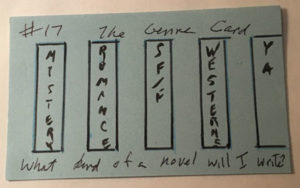 Novel Basics Card # 17
Novel Basics Card # 17
The Genre Card
The Genre Card asks the question,
“What kind of a novel will I write?”
Ordinarily, I don’t ascribe to the saying, “Write what you know” because when writers don’t know something they need to put in their books, they do research. But in this case, I advise that you write what you know. That is, you should write the kind of novel you’re most familiar with because you read novels in that genre all the time.
To narrow this down a little bit, let’s imagine you’re at the library and you’re looking for something tasty to read. Where do you go? To the children’s department even though you’re an adult? To the shelves filled with Science Fiction/Fantasy/Horror? Mysteries? Romance? Westerns? General Fiction that might include literary and historical novels? You should probably write whatever type of novel you check out and bring home from the library. (You can perform a similar exercise by figuring out which genre you gravitate to in your local Barnes & Noble or indie bookstore or on Amazon or Thriftbooks.)
To narrow the subject of the genre down even more, by the time you get to Card # 17, you’ve made quite a few decisions that affect the kind of book you’re writing, for instance, the gender and age of your protagonist. Consider the differences between Tucker MacBean, a boy just entering the Seventh Grade in present-day Kansas in Lisa Harkrader’s children’s novel Cool Beans: The Further Adventures of Beanboy, and grown-up Lady Edith aka Edie Gilchrist in Eloisa James’ take on the Rapunzel story in her fairy tale romance Once Upon a Tower set in London in 1824.
What sorts of plot developments you include will also affect what kind of book you end up writing. For instance, noir mystery fiction has loads more blood and guts, not to mention foul language and a cynical view of life, than your typical cozy.
But why does genre matter anyway?
Well, I assume that you might like a return on the time and effort it took you to write your novel by having people buy it, read it, and even review it once you’ve finished it. The chances of that happening increase if your novel fits in a niche, the smaller the better, so you won’t compete against authors like James Patterson in the Mystery, Thriller, and Suspense category of fiction, for example.
These days big genres like fantasy, mysteries, women’s fiction in general, and romance more specifically have developed many, very specific subgenres. For example, the cozy mystery subgenre can be further subdivided into culinary mysteries, cozy mysteries that include hobbies and crafts of all kinds, and cozy mysteries that have animals. There are even subcategories for Christian cozy mysteries and cozy mysteries with magic like the novels and stories in my Cinderella, P. I. fairy tale mysteries for grown-ups.
Jim Butcher practically invented a new sub-genre–urban fantasy–with his Harry Dresden series described by a reviewer as “magic and wizardry meet hard-boiled detective fiction.”
Books like Butcher’s Storm Front bring us to a bit of an issue. For years, the standard advice in publishing was to avoid crossovers or mashups for fear of confusing potential readers, but that didn’t seem to deter Butcher who has published fifteen novels as well as three story collections in the Dresden Files series. The popularity of Diana Gabaldon’s Outlander and its sequels seems not to be affected by their mix of time travel, adventure, and Scottish historical romance.
Next time we’ll explore the issue of genre a little more with the discussion of Card # 18.
